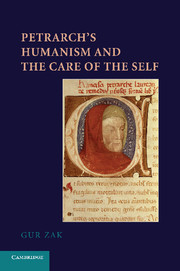Book contents
- Frontmatter
- Contents
- Acknowledgments
- Introduction
- 1 The Indeterminate Self: Writing, Desire, and Temporality in Petrarch's Rerum vulgarium fragmenta
- 2 The Crisis of the Narrative Self
- 3 Petrarch's Humanism and the Ethics of Care of the Self
- 4 Ovid, Augustine, and the Limits of the Ethics of Care of the Self
- Conclusion
- Bibliography
- Index
Introduction
Published online by Cambridge University Press: 24 April 2010
- Frontmatter
- Contents
- Acknowledgments
- Introduction
- 1 The Indeterminate Self: Writing, Desire, and Temporality in Petrarch's Rerum vulgarium fragmenta
- 2 The Crisis of the Narrative Self
- 3 Petrarch's Humanism and the Ethics of Care of the Self
- 4 Ovid, Augustine, and the Limits of the Ethics of Care of the Self
- Conclusion
- Bibliography
- Index
Summary
In a letter written to a friend, Giovanni Colonna of the Order of Preachers, Petrarch describes a tour the two had taken through the ruins of the ancient city of Rome. Fascinated by the surroundings of his beloved city, Petrarch nevertheless refrains from portraying the actual sites present to his eyes but rather flies on the wings of his imagination to the absent events and people to which the ruins allude: “here was the palace of Evander, there the shrine of Carmentis, here the cave of Cacus, there the nursing she-wolf and the fig tree of Rumina with the more apt surname of Romulus.” Starting thus with the description of the mythical origins of the city, Petrarch then continues his journey in space and time, advancing mostly linearly through the ages of Roman history, from these mythical origins through the glory of the Empire and early Christianity to the time of Constantine. He then concludes this short chronicle, lamenting not only that what is left from the glory of Rome is mere ruins but also that the significance of the ruins is mostly forgotten: “For today who are more ignorant about Roman affairs than the Roman citizens?” Ignorance, he adds, that is in turn complemented by the “flight and exile” (fugam exiliumque) of the many virtues that flourished in bygone times.
- Type
- Chapter
- Information
- Petrarch's Humanism and the Care of the Self , pp. 1 - 22Publisher: Cambridge University PressPrint publication year: 2010



